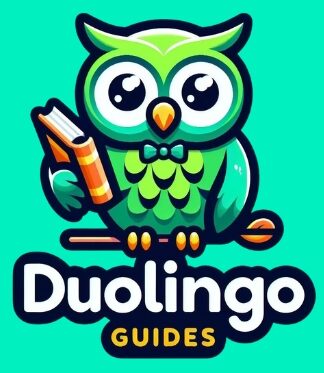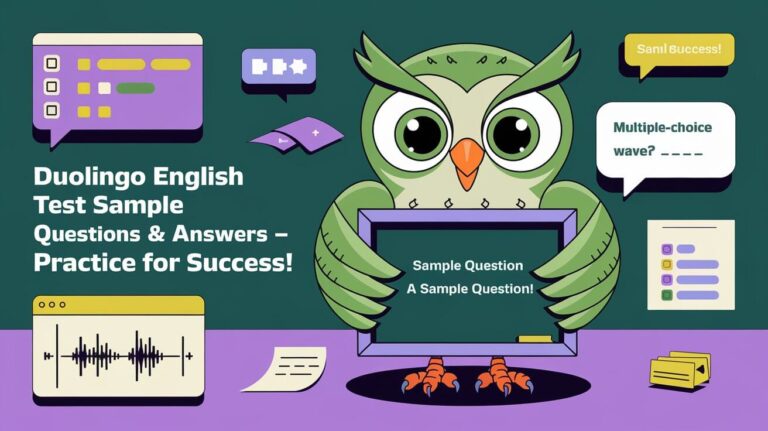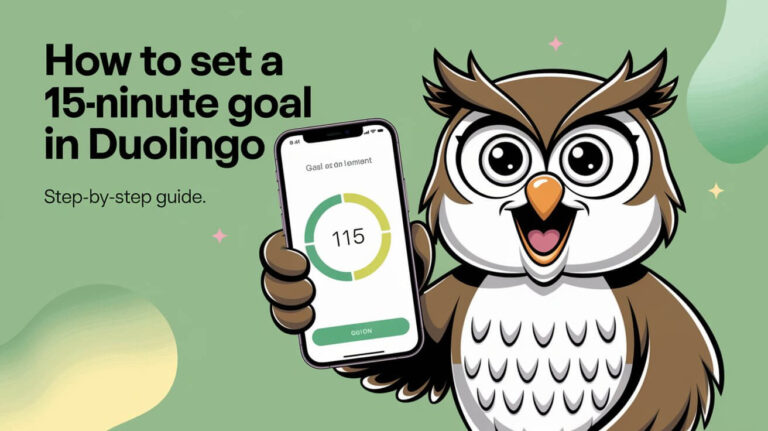Learning a new language can be an exhilarating journey, opening doors to new cultures, perspectives, and opportunities. In today’s interconnected world, the ability to communicate in multiple languages has become increasingly valuable, both personally and professionally. Among the myriad of language learning tools available, one app has risen to prominence: Duolingo, particularly for its French language course.
Is Duolingo a good way to learn French? Yes, Duolingo French can be an effective tool for learning the basics of the language, but it should be combined with other resources and practice methods to achieve fluency.
In this complete guide, we’ll explore the strengths and weaknesses of Duolingo French, evaluate its potential for helping learners achieve proficiency, and provide tips for maximizing the learning experience. We’ll also compare Duolingo to other language learning apps and traditional methods, addressing common questions and concerns along the way.
What is Duolingo?
Duolingo is a free language learning app that has gained immense popularity worldwide. Launched in 2011, it offers courses in over 40 languages, including French. The app’s unique approach combines gamification elements, such as earning points, maintaining streaks, and unlocking levels, with a variety of interactive exercises designed to teach vocabulary, grammar, reading, writing, listening, and speaking skills.
One of Duolingo’s key strengths is its accessibility. Available on multiple platforms, including smartphones, tablets, and computers, the app allows users to learn on the go, seamlessly integrating language practice into their daily routines.
The Good: Duolingo French’s Strengths
- Fun and Engaging Interface: Duolingo’s interface is visually appealing and user-friendly, featuring colorful illustrations, animations, and a cast of quirky characters. This playful approach helps make language learning enjoyable and less intimidating, particularly for beginners.
- Varied Exercises: The app offers a wide range of exercises, including translation (both from French to English and vice versa), listening comprehension, speaking practice through voice recognition, and fill-in-the-blank activities. This variety helps reinforce learning from multiple angles and keeps the experience fresh and engaging.
- Gamification and Progress Tracking: Duolingo’s gamification elements, such as earning points, maintaining streaks, and leveling up, can be highly motivating for many learners. The app also allows users to set daily goals and track their progress, encouraging consistent practice.
- Access to Stories and Podcasts: In addition to its core lessons, Duolingo offers a “Stories” feature that presents short dialogues and narratives for immersive learning. The app also has a French podcast, providing learners with valuable listening practice and exposure to authentic conversations.
- Free Access: While Duolingo offers a paid subscription called “Super Duolingo” with additional features, the core app and a significant portion of its content are available for free, making language learning accessible to a broader audience.
The Bad: Duolingo French’s Weaknesses
- Limited Grammar Explanations and Cultural Context: While Duolingo does introduce grammatical concepts, the explanations provided are often brief and may not offer sufficient depth for learners seeking a comprehensive understanding. Additionally, the app lacks a strong emphasis on cultural context, which is crucial for effective language learning.
- Occasional Inaccuracies or Unnatural Translations: Some users have reported instances where Duolingo’s translations or accepted answers may not align with how native speakers would naturally express themselves. This can be problematic, as learners may inadvertently reinforce incorrect or unnatural language patterns.
- Reliance on Computer-Generated Audio: While Duolingo’s voice recognition technology for speaking practice is impressive, the app primarily relies on computer-generated audio for pronunciation practice. These synthetic voices may not accurately replicate the nuances and intonations of native speakers, potentially hindering learners’ ability to develop natural-sounding pronunciation.
- Lack of Personalized Feedback or Conversational Practice: Duolingo’s exercises are designed for independent practice, with feedback limited to correct or incorrect answers. The app does not provide personalized guidance or opportunities for open-ended conversational practice, which is crucial for developing fluency.
Achieving Fluency with Duolingo French: Realistic Expectations
One of the most frequently asked questions about Duolingo French is whether it can lead to fluency in the language. The answer is both yes and no.
While Duolingo French can be an excellent resource for building a solid foundation in vocabulary, grammar, and basic language skills, it is unlikely to lead to complete fluency on its own. Fluency in a language encompasses not only mastery of its mechanics but also the ability to communicate effectively in various contexts, understand cultural nuances, and engage in natural, spontaneous conversations.
To achieve this level of proficiency, learners should supplement their Duolingo practice with additional resources and immersive experiences. This may include:
- Engaging with native speakers through language exchange programs or conversation clubs
- Consuming French media, such as books, movies, TV shows, and podcasts
- Taking formal language classes or working with a tutor for personalized guidance
- Traveling to French-speaking regions and immersing oneself in the language and culture
Duolingo French is a good starting point, but it’s not enough on its own to become fluent.
Maximizing Your Learning Experience with Duolingo French
To make the most of your Duolingo French experience, consider the following tips and strategies:
- Consistency is Key: Duolingo is designed for daily practice, even if it’s just for a few minutes. Establishing a consistent routine and maintaining your streak can help reinforce learning and make progress more sustainable.
- Read the Grammar Tips: While the in-app grammar explanations may be brief, Duolingo does provide additional guidance through its “Tips” sections. Take the time to read and understand these tips, as they can help solidify your understanding of the concepts being introduced.
- Engage with the Stories and Podcasts: Immerse yourself in the “Stories” feature and the Duolingo French podcast. These resources offer valuable exposure to authentic conversations and narratives, helping to train your ear and improve your listening comprehension skills.
- Supplement with Additional Resources: As mentioned, achieving fluency requires a well-rounded approach. Consider supplementing your Duolingo practice with other resources, such as language learning apps focused on conversation practice, French grammar books, or online courses that delve deeper into the intricacies of the language.
- Practice Speaking and Writing: While Duolingo offers speaking and writing exercises, consider seeking out opportunities to practice these skills in real-world scenarios. Language exchange partners, online forums, or even keeping a French journal can help reinforce what you’ve learned and build confidence in your communication abilities.
Duolingo French vs. Other Language Learning Apps and Methods
Duolingo is not the only language learning app on the market, and it’s essential to consider how it stacks up against other popular options and traditional methods. Here’s a brief comparison:
- Babbel: Unlike Duolingo’s gamified approach, Babbel takes a more structured, lesson-based approach to language learning. While it may be less engaging for some learners, Babbel is often praised for its comprehensive grammar explanations and focus on practical conversation skills.
- Rosetta Stone: Rosetta Stone is known for its immersive, image-based learning method, which aims to mimic the way children naturally acquire languages. While effective for some learners, this approach may not suit those who prefer explicit grammar instruction.
- Traditional Language Classes: In-person or online language classes taught by qualified instructors offer a comprehensive and structured learning experience. These classes typically cover grammar, vocabulary, pronunciation, and conversational practice, providing learners with personalized feedback and guidance. However, they can be more expensive and less flexible than app-based options.
- Self-Study with Textbooks and Audio Resources: For self-motivated learners, a combination of textbooks, audio resources (such as the popular Pimsleur method), and immersive materials like French literature and movies can be an effective approach. This method requires discipline and a willingness to seek out additional practice opportunities.
The best way to learn a language depends on personal preferences, styles, and goals. Some like Duolingo’s games, while others prefer classes or immersive methods like Rosetta Stone.
Frequently Asked Questions About Duolingo French
How long does it take to learn French with Duolingo?
The time it takes to learn French with Duolingo can vary significantly based on several factors, including your prior language learning experience, the amount of time you dedicate to practice, and your personal goals for proficiency.
According to Duolingo, if you consistently practice for 15 minutes per day, you can expect to reach a level where you can get a job in the language you’re studying in about 34 weeks (around 8 months). However, it’s essential to note that this estimate is based on the assumption that you are supplementing your Duolingo practice with additional resources and immersive experiences.
Realistically, the time it takes to achieve conversational fluency or a level where you can comfortably engage in most situations in French can range from several months to a year or more, depending on your dedication and the resources you utilize.
Is Duolingo better than Rosetta Stone for learning French?
Both Duolingo and Rosetta Stone are popular language-learning tools, but they take different approaches. Rosetta Stone is known for its immersive, image-based learning method, while Duolingo relies more on gamification and interactive exercises.
The “better” choice ultimately depends on your learning style and preferences. Rosetta Stone may be more effective for learners who thrive with immersive methods, while Duolingo’s gamified approach may appeal to those seeking a more engaging and accessible experience.
Rosetta Stone is a paid service, but Duolingo offers a lot of its content for free, making it a more accessible option.
Can Duolingo help me improve my French pronunciation?
Duolingo’s speaking exercises and voice recognition technology can help improve pronunciation, but they have limitations. The app primarily relies on computer-generated audio, which may not accurately replicate the nuances and intonations of native speakers.
To truly master French pronunciation, it’s recommended to supplement Duolingo with other resources, such as audio courses, podcasts, or conversation practice with native speakers.
Does Duolingo teach French grammar effectively?
While Duolingo introduces grammatical concepts through its exercises and provides brief explanations in the “Tips” sections, many learners find that the app’s grammar instruction is not comprehensive enough.
To develop a deeper understanding of French grammar, it’s advisable to supplement your Duolingo practice with grammar books, online resources, or formal language classes that offer more in-depth explanations and practice opportunities.
Conclusion
Duolingo French can be an excellent tool for learning the basics of the language, particularly for beginners or those seeking a low-cost, accessible option. Its gamified approach, varied exercises, and immersive stories and podcasts make language learning engaging and enjoyable.
Duolingo alone may not lead to complete fluency in French. To improve further, learners should use extra resources like conversation practice, media, and classes.
Ultimately, the key to successful language learning is consistency, a willingness to explore different methods, and a commitment to immersing oneself in the language and culture. By incorporating Duolingo into a well-rounded language learning strategy, learners can lay a solid foundation and embark on a rewarding journey toward mastering the beautiful French language.







